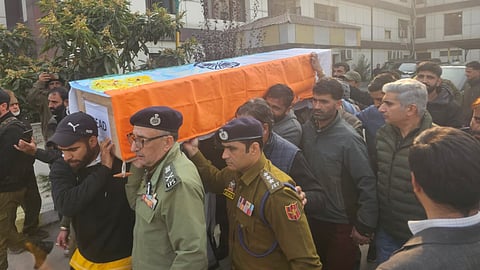

SRINAGAR: A devastating explosion tore through a police station in Nowgam, Srinagar, late Friday night, killing nine people and injuring 32 others when a massive haul of seized explosives accidentally detonated, according to Jammu & Kashmir police authorities.
The blast, which occurred around midnight on November 14-15, 2025, ripped through the Nowgam police station with catastrophic force, torching vehicles and shattering windows in nearby homes.
The explosion occurred where a haul of recoveries made in the Faridabad 'terror module' case were stored at a police station in Srinagar. A group of investigators from J&K police's State Investigation Agency (SIA), along with two officials from J&K's revenue department, five police personnel from the Forensic Science Laboratory (FSL) and Crime Branch, and a tailor, were at the facility preparing samples for exhibition of recoveries when disaster struck. They were all killed.
"The explosion was an accident," J&K Director General of Police Nalin Prabhat confirmed at a press conference in Srinagar on Saturday morning, while asserting that "any other speculation" around the cause of the blast at the Nowgam police station was "unnecessary."
Questions About Safety Protocols
The force of the explosion underscores the inherent dangers associated with storing seized explosive materials at active police facilities, raising serious questions about safety protocols and storage procedures across law enforcement agencies.
Most troublingly, the DGP revealed that "a haul of 2900 kg of explosives and other material, recovered from Faridabad earlier this week, was 'transported and kept securely in the open area of Nowgam police station.”
The storage of nearly three metric tons of explosives at an operational police station, reportedly in an "open area", represents a catastrophic failure of safety protocols. Standard operating procedures in most jurisdictions require seized explosives to be immediately transferred to specialized military-grade storage facilities or destroyed by trained bomb disposal units, precisely to prevent tragedies like this.
The fact that such a massive quantity of explosives was transported all the way from Faridabad in Haryana near Delhi to Srinagar and then stored at a working police station, rather than at a secure ammunition depot, raises urgent questions about J&K police's handling of dangerous materials.
Were safety protocols violated and under whose command? Some pertinent questions that the Jammu and Kashmir administration should answer:
1. If the explosives were already recovered in Delhi and Faridabad, what was the justification for transporting them to Kashmir?
2. For forensic purposes, only small samples are usually required. Why was a large cache, reportedly running into several hundred kilograms, moved instead of limited samples?
3. The forensic science laboratory responsible for examination is in Chandigarh, not Kashmir. Why was the material taken in the other direction?
4. Standard Operating Procedures (SOPs) exist for transporting explosive materials. Which SOPs were applied here, and why were they not followed?
5. The case material from the Red Fort blast falls under the jurisdiction of Kotwali police station in Daryaganj, or the National Investigation Agency in Delhi. Why was this explosive material not kept in the Delhi Police or NIA maalkhana as mandated?
6. Who authorised the decision to send the explosives to Srinagar police custody, and what paperwork supports that transfer?
7. Was there any risk assessment carried out before the transportation? If so, what did it conclude?
8. What security arrangements were in place while moving such a sensitive cache across states?
9. Were senior officers in Delhi Police or NIA informed about the movement of case property? If yes, what approvals were recorded?
10. If no approval exists, does this movement constitute a breach of procedure or tampering with case material?
11. Has the chain of custody been broken due to this unauthorised transfer, and what impact could that have on the admissibility of evidence?
12. DGP Nalin Prabhat's assertion that "any other speculation" about the blast was "unnecessary" may reflect an attempt to preempt questions about whether the explosion could have been prevented. However, the circumstances, 2,900 kg of explosives stored in an open area at a police station, subsequently detonating, necessitate a thorough investigation into what safety measures, if any, were in place.
The incident highlights a critical vulnerability in how seized dangerous materials are handled by police forces, particularly in regions where militant activity and arms trafficking remain ongoing security concerns.
The Faridabad "terror module" case that led to the seizure clearly involved significant quantities of explosives, yet the decision-making process that led to their storage at Nowgam police station, Srinagar, appears to have had fatal consequences.
Have you liked the news article?